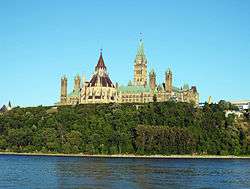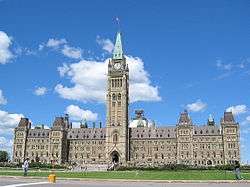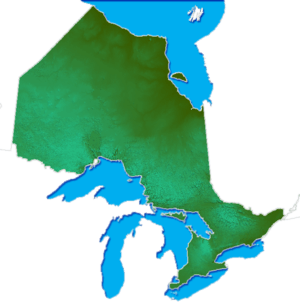Parliament Hill
Coordinates: 45°25′29″N 75°41′57″W / 45.424807°N 75.699234°W
| Parliament Hill Colline du Parlement | |
|---|---|
|
Parliament Hill, as viewed from Gatineau at sunset on a July 2014 summer's day | |
| Location | Ottawa River / Wellington Street, Downtown Ottawa |
| Built | 1859- |
| Built for | Legislature of the Province of Canada, Parliament of Canada |
| Architect |
Calvert Vaux, Marshall Wood (landscapes) Thomas Scott (oversight) |
| Visitors | 3 million annually |
| Governing body | |
| Official name | Parliament Buildings National Historic Site of Canada |
| Designated | 1976 |
| Official name | Grounds of the Parliament Buildings National Historic Site of Canada |
| Designated | 1976 |
Parliament Hill (French: Colline du Parlement), colloquially known as The Hill, is an area of Crown land on the southern banks of the Ottawa River in downtown Ottawa, Ontario. Its Gothic revival suite of buildings is the home of the Parliament of Canada and has architectural elements of national symbolic importance. Parliament Hill attracts approximately 3 million visitors each year.[1]
Originally the site of a military base in the 18th and early 19th centuries, development of the area into a governmental precinct began in 1859, after Queen Victoria chose Bytown as the capital of the Province of Canada. Following a number of extensions to the parliament and departmental buildings and a fire in 1916 that destroyed the Centre Block, Parliament Hill took on its present form with the completion of the Peace Tower in 1927. Since 2002, an extensive $1 billion renovation and rehabilitation project has been underway throughout all of the precinct's buildings; work is not expected to be complete until after 2020.
History
Early
Parliament Hill is a limestone outcrop with a gently sloping top that was originally covered in primeval forest of beech and hemlock.[2] For hundreds of years, the hill served as a landmark on the Ottawa River for First Nations and, later, European traders, adventurers, and industrialists, to mark their journey to the interior of the continent. After Ottawa—then called Bytown—was founded, the builders of the Rideau Canal used the hill as a location for a military base,[2] naming it Barrack Hill. A large fortress was planned for the site, but was never built, and by the mid 19th century the hill had lost its strategic importance.
Choice as a parliamentary precinct
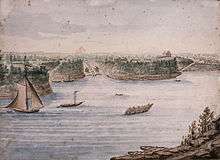
In 1858, Queen Victoria selected Bytown as the capital of the Province of Canada, and Barrack Hill was chosen as the site for the new parliament buildings, given its prominence over both the town and the river, as well as the fact that it was already owned by the Crown.[3] On 7 May, the Department of Public Works issued a call for design proposals for the new parliament buildings to be erected on Barrack Hill, which was answered with 298 submitted drawings. After the entries were narrowed down to three, Governor General Sir Edmund Walker Head was approached to break the stalemate, and the winners were announced on 29 August 1859.

The Centre Block, departmental buildings, and a new residence for the governor general were each awarded separately, the team of Thomas Fuller and Chilion Jones, under the pseudonym of Semper Paratus, winning the prize for the first category with their Victorian High Gothic scheme of a formal, symmetrical front facing a quadrangle, and a more rustic, picturesque back facing the escarpment overlooking the Ottawa River. The team of Thomas Stent and Augustus Laver, under the pseudonym of Stat nomen in umbra, won the prize for the second category, which included the East and West Blocks.[4] These proposals were selected for their sophisticated use of Gothic architecture, which was thought to remind people of parliamentary democracy's history, would contradict the republican Neoclassicism of the United States' capital, and would be suited to the rugged surroundings while also being stately.[4] $300,000 was allocated for the main building, and $120,000 for each of the departmental buildings.[4]
Development into a national heart
Ground was broken on 20 December 1859, and the first stones laid on 16 April of the following year, and Prince Albert Edward, Prince of Wales (later King Edward VII), laid the cornerstone of the Centre Block on 1 September.[5] The construction of Parliament Hill became the largest project undertaken in North America to that date. However, workers hit bedrock earlier than expected, necessitating blasting in order to complete the foundations, which had also been altered by the architects in order to sit 5.25 metres (17 ft) deeper than originally planned. By early 1861, Public Works reported that $1,424,882.55 had been spent on the venture, leading to the site being closed in September and the unfinished structures covered in tarpaulins until 1863, when construction resumed following a commission of inquiry.[4]

Two years later, the unfinished site hosted a celebration of Queen Victoria's birthday, further cementing the area's position as the central place for national outpouring. The site was still incomplete when three of the British North American colonies (now the provinces of Ontario, Quebec, Nova Scotia, and New Brunswick) entered Confederation in 1867, with Ottawa remaining the capital of the new country. Within four years Manitoba, British Columbia, Prince Edward Island, and the North-West Territories (now Alberta, Saskatchewan, Yukon, Northwest Territories, and Nunavut) were added and, along with the associated bureaucracy, the first three required representation be added in parliament. Thus, the offices of parliament spread to buildings beyond Parliament Hill even at that early date.[2][4]
The British military gave a nine-pound naval cannon to the British army garrison stationed in Ottawa in 1854. It was purchased by the Canadian government in 1869 and fired on Parliament Hill for many years as the "Noonday Gun".[6]
By 1876, the structures of Parliament Hill were finished, along with the surrounding fence and gates. However, the grounds had yet to be properly designed; Governor General the Marquess of Dufferin and Ava sent chief architect Thomas Scott to New York City to meet with Calvert Vaux and view Central Park. Vaux completed a layout for the landscape of Parliament Hill, including the present day driveways, terraces, and main lawn, while Scott created the more informal grounds to the sides of and behind the buildings.[4] In 1901 they were the site of both mourning for, and celebration of, Queen Victoria, when the Queen's death was mourned in official ceremonies in January of that year, and when, in late September, Victoria's grandson, Prince George, Duke of Cornwall (later King George V), dedicated the large statue that stands on the hill in the late queen's honour.[7]
Fire, rebuilding, and beyond
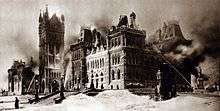
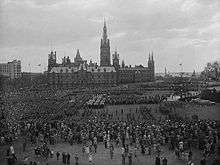
Fire destroyed the Centre Block on 3 February 1916. Despite the ongoing war, the original cornerstone was re-laid by Governor General Prince Arthur, Duke of Connaught, on 1 September 1916; exactly fifty-six years after his brother, the future King Edward VII, had first set it. Eleven years later, the new tower was completed and dedicated as the Peace Tower, in commemoration of the Canadians who had lost their lives during the First World War.[8]
Thereafter, The Hill hosted a number of significant events in Canadian history, including the first visit of the reigning Canadian sovereign—King George VI, with his consort, Queen Elizabeth—to his parliament, on 19 May 1939. VE Day was marked with a huge celebration on 8 May 1945, the first raising of the country's new national flag took place on 15 February 1965, the centennial of Confederation was celebrated on 1 July 1967, and the Silver Jubilee of Queen Elizabeth II was marked on 18 October 1977. The Queen was back on Parliament Hill on 17 April 1982, to issue a royal proclamation of the enactment of the Constitution Act that year.
In April 1989, a Greyhound Lines bus with 11 passengers on board travelling to New York City from Montreal was hijacked by an armed man and driven onto the lawn in front of the Centre Block. A standoff with police ensued and lasted eight hours; though three shots were fired, there were no injuries.[9] After a second incident in September 1996 where an individual forcibly drove his car into the Centre Block doors and proceeded to attack RCMP officers standing guard, it was decided in the interests of national security that Parliament Hill, which up to that time had been open to limited public traffic on the lower lawn, would be restricted to government and media vehicles only.
Crowds marked the beginning of the third millennium with a large ceremony on the quadrangle and the "largest single vigil" ever seen in the nation's capital took place in 2001, when 100,000 people gathered on the main lawn to honour the victims of the September 11 attacks on the United States that year.[10] The following year, Queen Elizabeth II's Golden Jubilee was marked on 13 October, as was her Diamond Jubilee on 6 February (Accession Day) 2012.
On 22 October 2014, several shooting incidents occurred around Parliament Hill. A gunman, after fatally shooting a Canadian Army soldier mounting the ceremonial guard at the National War Memorial, moved to the Centre Block of the parliament buildings. There, he was killed in a shootout with RCMP officers and the Sergeant-At-Arms, Kevin Vickers. The gunman also injured one guard, who was shot in the foot.[11]
Grounds and name
The 88,480 square metres (952,391 sq ft) area,[12] maintained by the National Capital Commission,[2] is named by the Parliament of Canada Act as Parliament Hill and defined as resting between the Ottawa River on the north, the Rideau Canal on the east, Wellington Street on the south, and a service road (Kent Street) near the Supreme Court on the west.[13] The south front of the property is demarcated by a Victorian High Gothic wrought iron fence, named the Wellington Wall and in the centre of which,[2] on axis with the Peace Tower to the north, sits the formal entrance to Parliament Hill: the Queen's Gates, forged by Ives & Co. of Montreal. At each southern corner of the quadrangle are also smaller gates for every-day access.
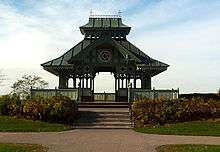
The main outdoor area of The Hill is the quadrangle, formed by the arrangement of the parliament and departmental buildings on the site, and laid out in a formal garden fashion. This expanse is the site of major celebrations, demonstrations, and traditional shows,[14] such as the changing of the guard, or the annual Canada Day celebrations. To the sides of the buildings, the grounds are set in the English garden style, dotted with statues, memorials, and, at the northwest corner, a Carpenter Gothic structure called the Summer Gazebo, a 1995 reconstruction of an earlier gazebo, Summer House, built for the Speaker of the House of Commons in 1877 by Thomas Seton Scott and demolished in 1956.[2] Beyond the edges of these landscaped areas, the escarpment remains in its natural state.[15]
Though Parliament Hill remains the heart of the parliamentary precinct, expansion beyond the bounded area described above began in 1884, with the construction of the Langevin Block across Wellington Street. After land to the east, across the canal, was purchased by private interests (to build the Château Laurier hotel), growth of the parliamentary infrastructure moved westward along Wellington, with the erection in the 1930s of the Confederation and Justice Buildings on the north side, and then further construction to the south. By the 1970s, the Crown began purchasing other structures or leasing space deeper within the downtown, civic area of Ottawa. In 1973, the Crown expropriated the entire block between Wellington and Sparks Streets with the intent of constructing a south block for Parliament Hill.[16] However, the government dropped this proposal and instead, constructed more office space in Hull, Quebec, such as the Terrasses de la Chaudière and Place du Portage.
In 1976, the Parliament Buildings and the grounds of Parliament Hill were each designated as National Historic Sites of Canada, given their importance as the physical embodiment of the Canadian government and as the focal point of national celebrations.[17]
The Parliament of Canada Act renders it illegal for anyone to name any other area or establishment within the National Capital Region as Parliament Hill, as well as forbidding the production of merchandise with that name on it. Any violation of this law is punishable on summary conviction.[18]
Parliament buildings
The parliament buildings are three edifices arranged around three sides of Parliament Hill's central lawn, the use and administration of the spaces within each building overseen by the speakers of each chamber of the legislature.[2] The Centre Block has the Senate and Commons chambers, and is fronted by the Peace Tower on the south facade, with the Library of Parliament at the building's rear. The East and West Blocks each contain ministers' and senators' offices, as well as meeting rooms and other administrative spaces. Gothic Revival has been used as the unifying style of all three structures, though the Centre Block is a more modern Gothic Revival, while the older East and West Blocks are of a Victorian High Gothic. This collection is one of the world's most important examples of the Gothic Revival style; while the buildings' manner and design are unquestionably Gothic, they resemble no building constructed during the Middle Ages. The forms were the same, but their arrangement was uniquely modern. The parliament buildings also departed from the Medieval models by integrating a variety of eras and styles of Gothic architecture, including elements from Britain, France, the Low Countries, and Italy, all in three buildings. In his 1867 Hand Book to the Parliamentary and Departmental Buildings, Canada, Joseph Bureau wrote
The style of the Buildings is the Gothic of the 12th and 13th Centuries, with modifications to suit the climate of Canada. The ornamental work and the dressing round the windows are of Ohio sandstone. The plain surface is faced with a cream-coloured sandstone of the Potsdam formation, obtained from Nepean, a few miles from Ottawa. The spandrils [sic] of the arches, and the spaces between window-arches and the sills of the upper windows, are filled up with a quaint description of stonework, composed of stones of irregular size, shape and color [sic], very neatly set together. These with the Potsdam red sandstone employed in forming the arches over the windows, afford a pleasant variety of color [sic] and effect, and contrast with the general masses of light coloured sandstone, of which the body of the work is composed.[19]
The sculptural ornament is overseen by the Dominion Sculptor;[20] five people have held the position since its creation in 1936: Cléophas Soucy (1936–50), William Oosterhoff (1949–62), Eleanor Milne (1962–93), Maurice Joanisse (1993–2006) and Phil R. White (2006–present).[2]
The only structure on Parliament Hill to have been purposefully demolished was the old Supreme Court building, which stood behind the West Block and housed the Supreme Court of Canada between 1889 and 1945. Throughout the 1950s and 1960s, there were proposals to demolish other parliamentary precinct buildings, including the Library of Parliament and West Block for new structures, and the East Block for parking, but none of these plans were adopted.[21] Instead, renovations were undertaken to the East Block, beginning in 1966.
In 2002, an extensive $1 billion renovation project began across the parliamentary precinct,[22][23][24] specifically focusing on masonry restoration, asbestos removal, vehicle screening, parking, electrical and mechanical systems, and improved visitors' facilities.[25] The Library of Parliament and Peace Tower, as well as some exterior areas of masonry on the Centre Block have so far been completed, though focus has shifted to the West Block due to its rapidly deteriorating cladding. In 2018, when the Centre Block is slated to be closed for five years to carry out an extensive interior restoration and upgrade, the inner courtyard of the newly renovated West Block will be enclosed and fitted with a temporary chamber for the House of Commons while the Senate will be temporarily relocated down Wellington St. in The Government Conference Centre. Restoration of the East block is set to commence upon completion of Centre Block's restoration.[25]
Statues and monuments
Most of the statues on Parliament Hill are arranged behind the three parliamentary buildings, with one outside of the main fence.
| Figure | Portrait | Statue | Notes |
|---|---|---|---|
| Sir George-Étienne Cartier |  | 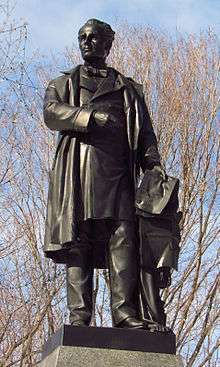 | This was the first statue erected on Parliament Hill, to the immediate west of the Centre Block, at the instigation of Sir John A. Macdonald. From amongst proposals from Canada, the United States, the United Kingdom, and Italy, Louis-Philippe Hébert was chosen to form the monument, which was set up in the 1880s. |
| Sir John A. Macdonald |  |  | Louis-Philippe Hébert was selected from 44 submissions from Canada, the United States, the United Kingdom, and Europe, to sculpt the statue of Canada's first prime minister. In the 1880s, it was unveiled at the south east corner of the Centre Block. |
| Queen Victoria |  |  | Located at the north-west corner between the West and Centre Blocks, the statue of the country's first monarch was sculpted by Louis-Philippe Hébert in 1900, and dedicated by Prince George, Duke of Cornwall and York, in 1901. |
| Alexander Mackenzie |  |  | Placed directly to the north of the statue of George-Étienne Cartier, Louis-Philippe Hébert was commissioned to sculpt this figure at the same time as he was awarded the project of the monument to Queen Victoria. The statue was unveiled in 1901. |
| Sir Galahad |  |  | This is the only statue on Parliament Hill that is not of a monarch or politician, or within the site's fences. It was installed in 1905, at the initiative of the future prime minister William Lyon Mackenzie King, in order to honour the bravery of his friend Henry Albert Harper and is the work of Ernest Wise Keyser. |
| George Brown | 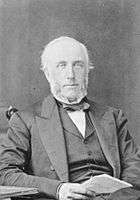 | .jpg) | This statue was created by George William Hill, and erected in 1913, just north of the monument to Alexander Mackenzie. |
| D'Arcy McGee |  | | The competition for this sculpture took place simultaneously with that for the rendition of George Brown, and was won also by George William Hill. It was unveiled in 1913, at its location northwest of the Library of Parliament. |
| Robert Baldwin and Sir Louis-Hippolyte Lafontaine |   |  | This dual statue by Walter Seymour Allward has occupied the site at the northeast corner of the parliamentary precinct since 1914. |
| Sir Wilfrid Laurier |  |  | This work by Joseph-Émile Brunet was selected from 40 entries received from around the world and was placed at the southeast corner of the site in 1922. |
| Sir Robert Borden | 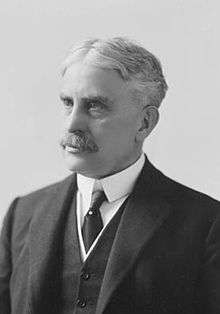 | 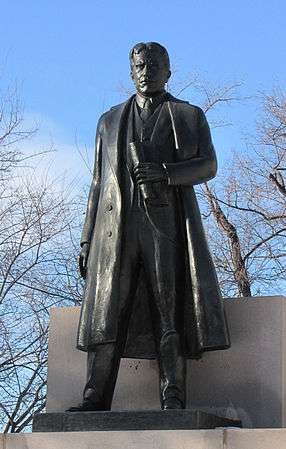 | Frances Loring cast this likeness for the 1957 session of parliament opened by Queen Elizabeth II; it stands at the southwest corner of Parliament Hill. |
| William Lyon Mackenzie King |  |  | This statue was commissioned for the Canadian Centennial in 1967, designed by Raoul Hunter, and stands at the northwest corner of the East Block. |
| John Diefenbaker | 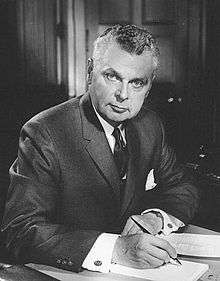 |  | This statue was initiated by an Act of Parliament, and Leo Mol was chosen from 21 submissions to sculpt this 1985 work, which stands immediately north of the West Block. |
| Lester B. Pearson |  |  | In 1989, Danek Mozdzenski was commissioned to form this monument that rests immediately north of the West Block. |
| Queen Elizabeth II |  |  | Situated in the opposite corner of the site from the statue of her great-great-grandmother, the monument was sculpted by Jack Harman and unveiled in 1992, in the presence of the Queen, as part of the 125th anniversary of Confederation celebrations. |
| The Famous Five |  |  | This monument was donated in 2000 to the Crown by the Famous 5 Foundation and is a collection of five individual statues, by Barbara Paterson, of each of The Famous Five—Emily Murphy, Irene Parlby, Nellie McClung, Louise McKinney, and Henrietta Edwards— as well as one empty chair. It is located at the east edge of the precinct, to the south of the statue of Queen Elizabeth II. |
A number of other monuments are distributed across the hill, marking historical moments or acting as memorials for larger groups of people.
| Monument | Image | Notes |
|---|---|---|
| Centennial Flame |  | Lester B. Pearson dedicated this fountain and flame on 1 January 1967, to mark the beginning of the Canadian Centennial. |
| Canadian Police Memorium | | This memorial was designed and constructed to honour Canadian police officers killed in the line of duty since 1879. Dedicated on 22 March 1994, the memorial has since been expanded to include the names of fallen officers from all law enforcement agencies, including the Ministry of Natural Resources, the Ministry of Fisheries and Oceans, and the Ministry of Conservation. |
| Victoria Tower Bell |  | Unveiled in 2000, the bell is the original from the Victoria Tower, and is canted to recall the way in which it was found after it fell from its perch in the fire of 1916. |
| War of 1812 Monument | Seven figures—a First Nations individual, a Métis militiaman, a British infantryman, a Quebec Voltigeur, a woman bandaging one of them, a Royal Navy marine, a farmer—represent the War of 1812.[26] Also part of the monument is a maple tree planted in soil taken from 10 Canadian battlefield sites and watered at the dedication with water from six oceans and lakes significant in the War of 1812. It was dedicated on 6 November 2014, the 200th anniversary of the war's final battle in Canada, the Battle of Malcolm's Mills.[27] |
See also
- Canadian Parliamentary Cats
- Government Hill
- Capitol Hill
- Parliament Hill, London
- Parliamentary Triangle, Canberra
References
- ↑ Canadian Press (6 May 2007). "Parliament Hill tourist facilities overwhelmed". CTV. Retrieved 9 January 2009.
- 1 2 3 4 5 6 7 8 Bosc, Marc; O'Brien, Audrey (2009). "The Parliament Buildings and Grounds". House of Commons Procedure and Practice (2 ed.). Ottawa: Queen's Printer for Canada. ISBN 978-2-89635-321-7.
- ↑ Public Works and Government Services Canada (26 February 2013). "Pre-construction, 1826-1858". Queen's Printer for Canada. Retrieved 10 May 2013.
- 1 2 3 4 5 6 Public Works and Government Services Canada (27 March 2013). "Building The Hill". Queen's Printer for Canada. Archived from the original on October 6, 2011. Retrieved 10 May 2013.
- ↑ "Ottawa Becomes Canada's Capital". City of Ottawa. Retrieved 10 May 2013.
- ↑ Department of National Defence. "Noonday Gun". Queen's Printer for Canada. Retrieved 16 May 2014.
- ↑ Hubbard, R.H. (1977). Rideau Hall. Montreal and London: McGill-Queen’s University Press. pp. 101–106. ISBN 0-7735-0310-2.
- ↑ Public Works and Government Services Canada. "Peace Tower". Queen's Printer for Canada. Retrieved 9 January 2009.
- ↑ "Gunman Hijacks Greyhound Bus in Canada, Surrenders". Los Angeles Times. latimes.com. United Press International. 8 April 1989. Retrieved 10 May 2013.
- ↑ "Interview With Pervez Musharraf; Interview With Paul Martin; Interview With Kweisi Mfume". CNN Late Edition with Wolf Blitzer. CNN. 5 December 2004.
- ↑ Multiple. "Soldier fatally shot outside of Parliament, one gunman killed". The National Post. Retrieved 22 October 2014.
- ↑ "The Hill Grounds". Queen's Printer for Canada. Retrieved 10 May 2013.
- ↑ "Parliament of Canada Act". 80.1. Ottawa: Queen's Printer for Canada (published 9 July 2007). 2007. Retrieved 5 August 2010.
- ↑ House of Commons (22 October 1999). "Building the Future" (PDF). Circulation. Ottawa: Queen's Printer for Canada: 54. Retrieved 12 January 2009.
- ↑ House of Commons 1999, p. 48
- ↑ House of Commons 1999, pp. 3–5
- ↑ Parliament Buildings. Canadian Register of Historic Places. Retrieved August 2, 2011. ; Public Grounds of the Parliament Buildings. Canadian Register of Historic Places. Retrieved August 2, 2011.
- ↑ Elizabeth II 2007, 80.1-80.2
- ↑ Nixon, Don (2012). The Other Side of the Hill. Lulu.com. pp. 83–84. ISBN 9781105408823.
- ↑ Public Works and Government Services Canada (July 2012). "Dominion Sculptor Phil White receives Diamond Jubilee Medal". Queen's Printer for Canada. Retrieved 10 May 2013.
- ↑ Public Works and Government Services Canada. "Reconstruction, 1916-1965". Queen's Printer for Canada. Retrieved 10 May 2013.
- ↑ "Parliament Hill blocks need $1B facelift". Toronto Star. thestar.com. The Canadian Press. 20 July 2008. Retrieved 10 May 2013.
- ↑ Koroluk, Korky (29 October 2007). "Masonry deterioration sparks review of Parliament Hill's repair plans". Daily Commercial News. Retrieved 10 May 2013.
- ↑ "Parliament Hill renovation costs climb past $1 billion". The Telegram. The Canadian Press. 20 July 2008. Retrieved 10 May 2013.
- 1 2 Public Works and Government Services Canada (13 March 2013). "Restoring The Hill". Queen's Printer for Canada. Retrieved 10 May 2013.
- ↑ Whyte, Murray (27 June 2014). "Toronto sculptor Adrienne Alison creates monument to War of 1812". Toronto Star. Retrieved 15 November 2014.
- ↑ "War of 1812 monument unveiled on Parliament Hill". Ottawa Citizen. 7 November 2014. Retrieved 15 November 2014.
Further reading
- Bourrie, Mark (1996), Canada's Parliament Buildings, Hounslow Press, ISBN 0-88882-190-5
- Van Dusen, Thomas; Susan Code (1998), Inside the tent: forty-five years on Parliament Hill, General Store Publishing House, ISBN 1-896182-86-0 Cite uses deprecated parameter
|coauthor=(help) - Young, Carolyn Ann (1995), The glory of Ottawa: Canada's first parliament buildings, McGill-Queen's University Press, ISBN 0-7735-1227-6
External links
![]() Media related to Parliament Hill at Wikimedia Commons
Media related to Parliament Hill at Wikimedia Commons
- Parliament Hill Website
- Canada by Design: Parliament Hill, Ottawa at Library and Archives Canada
- M.H. Stoneworks Inc. images of the restoration of various buildings on Parliament Hill
